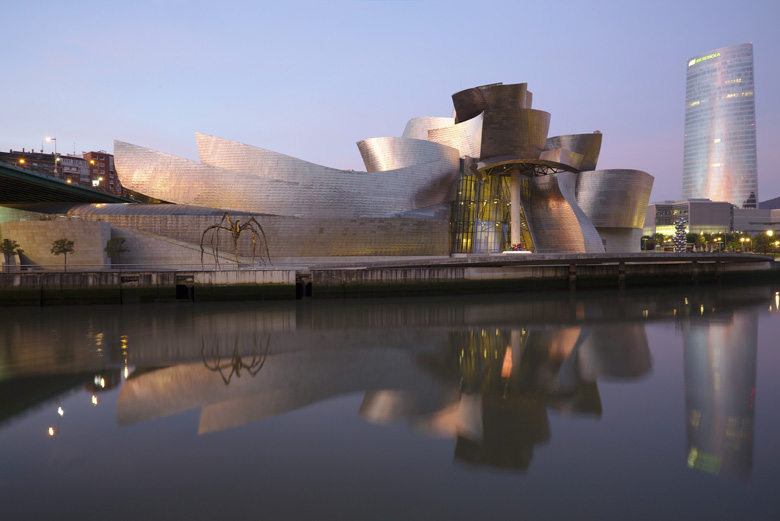Frank Gehry and his unconventional architecture
Rarely do architects rise to fame and become well-known individuals. Frank Gehry, meanwhile, has never adhered to any conventional wisdom. The distinguished architect has spent more than 50 years upending the basic definition of design in architecture.
The magnificent Guggenheim Museum in Bilbao, dubbed by Philip Johnson as “the greatest structure of our time,” and the Fondation Louis Vuitton in Paris are just two examples of Gehry‘s many works demonstrating the power that can be created when whimsical design is executed skillfully.

Gehry, who was born in Canada in 1929, attended the Harvard Graduate School of Design and the University of Southern California.
He started out in Los Angeles, working for Pereira and Luckman and Victor Gruen Associates. He briefly worked with Andre Remondet in Paris before returning to California in 1962 to launch his own business.
In 1989, Gehry received the Pritzker Prize. There is never a wrong time to honor Gehry‘s body of work because he seems to have no boundaries. AD lists 31 of his most well-known buildings from around the world below.
Fondation Louis Vuitton, Paris

Commissioned by LVMH chief Bernard Arnault and completed in 2014, Frank Gehry’s Fondation Louis Vuitton is set in Paris’s Bois de Boulogne park. The shiplike exterior includes 12 glass “sails,” which cover the concrete-clad gallery spaces.
Walt Disney Concert Hall, Los Angeles

When Gehry‘s design for the Walt Disney Concert Hall, the new home for the Los Angeles Philharmonic, was being considered in 1988, it was completed in 2003.
Today, both the public and critics concur that the famous structure was worth the wait. The building’s facade has swaths of stainless steel that billow over Grand Avenue, reflecting Gehry‘s lifelong love of sailing. Inside, the auditorium is lined with Douglas fir panels that have a similar shape.
Biomuseo, Panama City

Late in the 1990s, politicians in Panama started corresponding with Gehry about creating an ecology museum in an effort to create their own “Bilbao Effect.” But the project wasn’t actually completed until 2013 at the earliest.
The recently opened Biomuseo is marked by a colorfully distorted roofline that is supported in place by what looks to be an enormous billboard structure at the Amador Causeway in Panama City.
Gehry frequently uses techniques that reveal the underlying structure, but his unusual use of reds, greens, and other striking colors pays homage to Panama’s varied flora and fauna.
According to the 2010 World Architecture Survey, his creations are among the most significant examples of modern architecture.
Here are some of the honors he received as a result of his unique creations:
- 1987: Fellow of American Academy of Arts and Letters
- 1988: Elected into the National Academy of Design
- 1989: Pritzker Architecture Prize
- 1992: Praemium Imperiale
- 1994: The Dorothy and Lillian Gish Prize
- 1995: American Academy of Achievement’s Golden Plate Award
- 1998: National Medal of Arts
- 1998: Gold Medal Award, Royal Architectural Institute of Canada
- 1999: AIA Gold Medal, American Institute of Architects
- 2000: Cooper–Hewitt National Design Award Lifetime Achievement
- 2002: Companion of the Order of Canada
- 2004: Woodrow Wilson Award for Public Service
- 2006: Inductee, California Hall of Fame
- 2007: Henry C. Turner Prize for Innovation in Construction Technology from the National Building Museum (on behalf of Gehry Partners and Gehry Technologies)
- 2009: Order of Charlemagne
- 2012: Twenty-five Year Award, American Institute of Architects
- 2014: Prince of Asturias Award
- 2014: Commandeur of the Ordre National de la Légion d’honneur, France
- 2015: J. Paul Getty Medal
- 2016: Harvard Arts Medal
- 2016: Leonore and Walter Annenberg Award for Diplomacy through the Arts, Foundation for Arts and Preservation in Embassies
- 2016: Presidential Medal of Freedom
- 2018: Neutra Medal
- 2019: Inductee, Canada’s Walk of Fame
- 2020: Paez Medal of Art, New York City (VAEA).
The American Institute of Architects (AIA) inducted Gehry into its College of Fellows in 1974, and since then, he has won numerous national, regional, and local AIA accolades.
He is a senior fellow of the Design Futures Council and a member of the Aga Khan Award for Architecture steering group.
